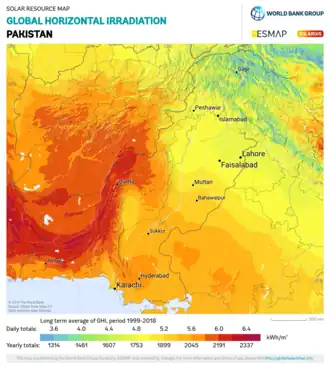
| Electricity generation in Pakistan |
|---|
 |
Pakistan has some of the highest values of insolation in the world, with eight to nine hours of sunshine per day, ideal climatic conditions for solar power generation. However, the country has been slow to adopt the technology. Despite electricity tariffs in Pakistan being some of highest in the world, total solar power installed capacity in Pakistan was only 568 MWAC in 2022.
The country has solar plants in Pakistani Kashmir, Punjab, Sindh and Balochistan. Initiatives are under development by the International Renewable Energy Agency, the Japan International Cooperation Agency, Chinese companies, and Pakistani private sector energy companies. The country aims to build the Quaid-e-Azam Solar Power Park (QASP) in the Cholistan Desert, Punjab, by 2017 with a 1 GW capacity. A plant of this size would be enough to power around 320,000 homes.[1]
Solar resource
Solar irradiance in Pakistan is 5.3 kWh/m2/day.[2]
Government policy
Raja Pervaiz Ashraf, the Federal Minister of Water & Power of Pakistan, announced on 2 July 2009 that 7,000 villages would be electrified using solar energy by 2014. Senior adviser Sardar Zulfiqar Khosa stated that the Punjab government would begin new projects aimed at power production through coal, solar energy and wind power; this would generate additional resources.[3]
The Government of Pakistan allowed the provincial government of Sindh to conduct feasibility research. The government planned to install a desalination plant powered by solar energy.[4]
On 21 May 2022, Prime Minister Shehbaz Sharif announced the removal of 17 per cent general sales tax on solar panels.[5]
Projects
- Beaconhouse installed the first high quality integrated solar energy system with a 10 kW power generation capacity capable of grid tie-in at Beaconhouse Canal Side Campus, Lahore. It was a pilot project for BSS designed by U.S. consultants, based upon feasibility by the U.S. Trade and Development Agency (USTDA).[6][7]
- 50 to 100 MW of photovoltaics is expected to be installed in 2013, and at least 300 MW in 2014.[8] In May 2015, 100 MW of a planned 1,000 MW were installed in the Quaid-e-Azam Solar Park.[9]
- The progress of net metering in Pakistan up to 31 October 2021 is 268.69 MW commissioned systems.[10]
See also
References
- ↑ Ebrahim, Zofeen T. (8 September 2015). "World's largest solar park to light up Pakistan's future". Archived from the original on 8 December 2020. Retrieved 4 August 2016.
- ↑ "Potentials of Solar Thermal for Electricity use in Pakistan" (PDF). Archived (PDF) from the original on 14 February 2019. Retrieved 29 May 2012.
- ↑ "Dead link". Archived from the original on 15 May 2016. Retrieved 14 November 2009.
- ↑ "Dead link". Archived from the original on 15 May 2016. Retrieved 14 November 2009.
- ↑ Ayub, Imran (21 May 2022). "PM removes 17pc GST on solar panels". Dawn. Pakistan. Archived from the original on 21 May 2022. Retrieved 21 May 2022.
- ↑ "Pakistan gets first on-grid solar power station". Archived from the original on 5 June 2016. Retrieved 27 June 2012.
- ↑ "The Beaconhouse Times Online - Solar Panels Installed at Canal Side Campus". Tbt.beaconhouse.net. Archived from the original on 3 March 2016. Retrieved 13 June 2014.
- ↑ "Punjab, German firm ink solar energy MoU". Archived from the original on 14 September 2013. Retrieved 13 January 2013.
- ↑ "Quaid-e-Azam Solar Park: Solar energy's 100MW to arrive in April". The Express Tribune. 27 March 2015. Archived from the original on 18 December 2020. Retrieved 17 May 2015.
- ↑ "Progress of Net Metering in Pakistan upto October 31, 2021". aedb.org. Archived from the original on 14 May 2021. Retrieved 14 May 2021.